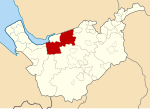Holy Trinity Church, Runcorn
1838 establishments in England19th-century Church of England church buildingsBuildings and structures in RuncornChurch of England church buildings in CheshireChurches completed in 1857 ... and 4 more
Diocese of ChesterGothic Revival architecture in CheshireGothic Revival church buildings in EnglandGrade II listed churches in Cheshire

Holy Trinity Church is in Runcorn, Cheshire, England. It is an active Anglican parish church in the diocese of Chester, the archdeaconry of Chester and the deanery of Frodsham. Its benefice is combined with that of All Saints, Runcorn. It is recorded in the National Heritage List for England as a designated Grade II listed building.
Excerpt from the Wikipedia article Holy Trinity Church, Runcorn (License: CC BY-SA 3.0, Authors, Images).Holy Trinity Church, Runcorn
Thomas Street,
Geographical coordinates (GPS) Address External links Nearby Places Show on map
Geographical coordinates (GPS)
| Latitude | Longitude |
|---|---|
| N 53.3422 ° | E -2.72817 ° |
Address
Holy Trinity
Thomas Street
WA7 1BU , Higher Runcorn
England, United Kingdom
Open on Google Maps









